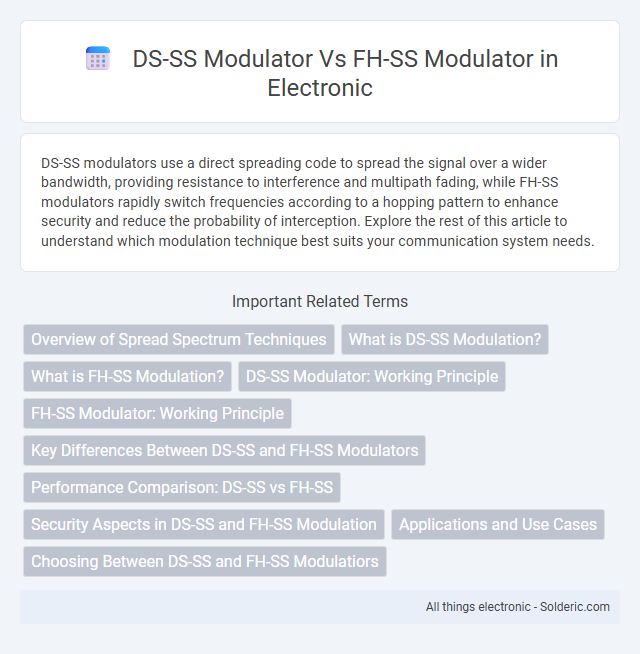DS-SS modulators use a direct spreading code to spread the signal over a wider bandwidth, providing resistance to interference and multipath fading, while FH-SS modulators rapidly switch frequencies according to a hopping pattern to enhance security and reduce the probability of interception. Explore the rest of this article to understand which modulation technique best suits your communication system needs.
Comparison Table
| Feature | DS-SS Modulator | FH-SS Modulator |
|---|---|---|
| Definition | Direct Sequence Spread Spectrum modulates data by spreading it with a pseudo-random noise code. | Frequency Hopping Spread Spectrum transmits by hopping between multiple frequency channels. |
| Spreading Method | Spreads signal spectrum using a high-rate chip sequence. | Changes carrier frequency rapidly at set intervals. |
| Bandwidth Utilization | Wide instantaneous bandwidth due to spreading. | Uses narrow bandwidth but hops across wide spectrum. |
| Interference Resistance | Good resistance to narrowband interference. | Strong resistance to frequency-selective interference. |
| Complexity | Moderate; requires precise code synchronization. | Higher; needs fast frequency synthesizers and synchronization. |
| Security | High security due to spreading code secrecy. | High security by unpredictable frequency hopping patterns. |
| Example Uses | GPS, CDMA cellular networks. | Military communication, Bluetooth frequency hopping. |
Overview of Spread Spectrum Techniques
Direct Sequence Spread Spectrum (DS-SS) modulator spreads the signal by multiplying the data with a pseudo-random noise code at a higher frequency, enhancing resistance to interference and eavesdropping. Frequency Hopping Spread Spectrum (FH-SS) modulator rapidly changes the carrier frequency according to a pseudo-random sequence, minimizing the impact of narrowband interference and improving signal security. You can choose between DS-SS for continuous spreading or FH-SS for frequency agility based on system requirements such as interference resilience and complexity.
What is DS-SS Modulation?
DS-SS modulation, or Direct Sequence Spread Spectrum modulation, spreads the data signal by multiplying it with a high-rate pseudo-random code sequence, increasing the signal bandwidth significantly beyond the original data bandwidth. This technique enhances resistance to interference, jamming, and eavesdropping while providing robust signal performance in multipath and noisy environments. DS-SS modulators are commonly used in GPS, CDMA cellular systems, and wireless communications for secure and reliable data transmission.
What is FH-SS Modulation?
FH-SS modulation, or Frequency-Hopping Spread Spectrum modulation, rapidly changes the carrier frequency over a wide band according to a specific sequence, improving resistance to interference and eavesdropping. Unlike DS-SS modulation, which spreads the signal across a wide frequency band simultaneously, FH-SS transmits signals by hopping between frequencies, enhancing security and reducing the likelihood of signal jamming. If you're designing a secure communication system, understanding the trade-offs between FH-SS's frequency agility and DS-SS's spreading techniques is crucial for optimal performance.
DS-SS Modulator: Working Principle
DS-SS modulator operates by spreading the data signal across a wider bandwidth using a pseudo-random noise (PN) sequence, enhancing resistance to interference and eavesdropping. This technique modulates the carrier by multiplying the data with the spreading code, creating a signal that appears noise-like to unintended receivers. Your communication system benefits from increased security and robustness through the DS-SS modulator's precise control of its spreading sequence.
FH-SS Modulator: Working Principle
FH-SS modulator functions by rapidly switching the carrier frequency among many predetermined channels according to a pseudorandom sequence, spreading the signal over a wide frequency band. This frequency hopping technique provides robustness against interference, multipath fading, and enhances security by making it difficult for unauthorized receivers to intercept the transmission. Your communication system benefits from FH-SS modulators through improved resistance to jamming and reliable data transfer in noisy environments.
Key Differences Between DS-SS and FH-SS Modulators
DS-SS modulators use a fixed spreading code to spread the signal over a wide frequency band, providing resistance to narrowband interference and multipath fading. FH-SS modulators continually change the carrier frequency according to a pseudorandom sequence, enhancing security and robustness against jamming by rapidly hopping across frequencies. Your choice depends on whether you prioritize stable signal spreading for interference rejection (DS-SS) or dynamic frequency hopping for anti-jamming and secure communications (FH-SS).
Performance Comparison: DS-SS vs FH-SS
DS-SS modulators provide superior performance in terms of resistance to narrowband interference and better spectral efficiency due to their direct spreading of the signal with a high-rate pseudorandom code. FH-SS modulators excel in frequency diversity and robustness against multipath fading by rapidly switching carrier frequencies over a wide band, enhancing anti-jamming capabilities. In environments with predominant narrowband interference, DS-SS outperforms FH-SS, while FH-SS is preferred in dynamic spectral environments with significant frequency-selective fading.
Security Aspects in DS-SS and FH-SS Modulation
DS-SS modulation provides security through spreading data over a wide frequency band using a pseudorandom noise code, making unauthorized interception and jamming difficult by mimicking noise. FH-SS modulation enhances security by rapidly changing carrier frequencies according to a pseudorandom sequence, which complicates signal detection and interception by eavesdroppers. Both techniques resist narrowband interference and improve confidentiality, but FH-SS offers increased resilience against frequency-specific jamming due to its hopping nature.
Applications and Use Cases
DS-SS modulators excel in low-power, short-range communication systems such as GPS and cordless telephones, providing resistance to narrowband interference and multipath fading. FH-SS modulators are preferred in military and secure communication applications where frequency hopping enhances anti-jamming and interception avoidance capabilities. Your choice between DS-SS and FH-SS modulators depends on requirements for signal robustness, security, and operational environment.
Choosing Between DS-SS and FH-SS Modulatiors
Choosing between DS-SS and FH-SS modulators depends on the specific application requirements for interference resistance and complexity. DS-SS modulators offer higher data rates and simpler receiver design, making them ideal for bandwidth-efficient systems. FH-SS modulators provide superior resistance to jamming and multipath fading, suited for secure communication in highly dynamic environments.
DS-SS modulator vs FH-SS modulator Infographic

 solderic.com
solderic.com